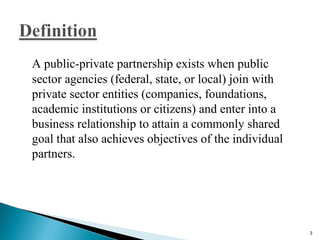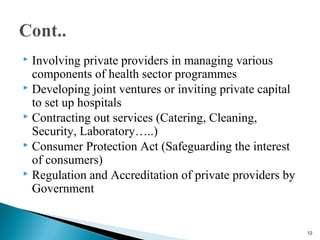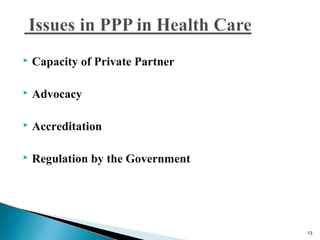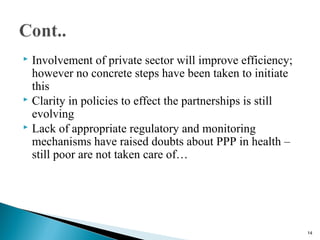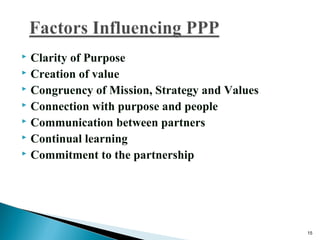Ppp
- 1. Presented By: Heena Vasdev Bakul Arora 1
- 2. It is a joint ownership of a program/ proposal by two or more parties to achieve a common goal. It is a higher level of collaboration. 2
- 3. A public-private partnership exists when public sector agencies (federal, state, or local) join with private sector entities (companies, foundations, academic institutions or citizens) and enter into a business relationship to attain a commonly shared goal that also achieves objectives of the individual partners. 3
- 4. Super-ordinate Goal High perceived pay-off to both parties Equal power with both parties Mutual Trust 4
- 5. Joint action at all stages (from planning, follow up and termination) Complimentary roles (expectation of each other are clarified and stabilized) Creation of a temporary system (task force with representatives from both sides) Continuous Communication (lines of communication between partners to be always kept open) 5
- 6. P3 is a tool that can help governments meet demands for the development of modern and efficient facilities, infrastructure and services. Growing Public demand for services. 6
- 7. PPP in health is an approach to addressing public health problems through the combined efforts of public, private and development organisations complimenting each other by contributing or sharing their core competency . This synergy leads to better outcome of goals 7
- 8. It has a desired health outcome. It means to achieve better community health It is a specific strategy to achieve better community health. 8
- 9. Contracting out to manage clinical and non-clinical services; health projects Joint ventures; private capital to set up hospitals Incentives system to influence desired geographic distribution of health facilities – qualified providers through contract mechanisms in rural areas 9
- 10. Develop strategies to utilise untapped resources and strengths of the private sector Enhance the capacity to meet growing health needs Reducing financial burden of government expenditure on tertiary care Reducing geographical disparity in provision of services and its access Reaching remote areas; target specific group of populations Improving efficiency through evolving new management structures 10
- 11. Cost containment Effective use of private resources Logical diversion of public resources Synergy to reduce duplication Resource mobilization 11
- 12. Involving private providers in managing various components of health sector programmes Developing joint ventures or inviting private capital to set up hospitals Contracting out services (Catering, Cleaning, Security, Laboratory…..) Consumer Protection Act (Safeguarding the interest of consumers) Regulation and Accreditation of private providers by Government 12
- 13. Capacity of Private Partner Advocacy Accreditation Regulation by the Government 13
- 14. Involvement of private sector will improve efficiency; however no concrete steps have been taken to initiate this Clarity in policies to effect the partnerships is still evolving Lack of appropriate regulatory and monitoring mechanisms have raised doubts about PPP in health – still poor are not taken care of… 14
- 15. Clarity of Purpose Creation of value Congruency of Mission, Strategy and Values Connection with purpose and people Communication between partners Continual learning Commitment to the partnership 15
- 16. Health System Development Projects National Rural Health Mission Blindness Control Diagnostic Support within Medical College Hospitals 16
- 17. Public-Private partnerships in health are at very early stages Will need significant institutional development work in terms of financial analysis capabilities, monitoring and evaluations systems Appropriate regulations to check the unintended outcomes of private sector growth in health 17
- 18. 18 Thank You!!
Editor's Notes
- Shiv Chandra Mathur is a public health specialist working for developing human resources for health. His current assignment involves organizing in-service trainings for health professionals in India. Throughout the developing world a transition has begun where delivery of health services are being gradually handed over from public system to provate sector. In this backgound, it Managers of Health System must have a conceptual clarity on Public-Private Partnership. This presentation is an illustration of the same case. Viewers/Readers are welcome to share their observations/comments with author at [email_address] They may go through related lecture from the author in super-course series


